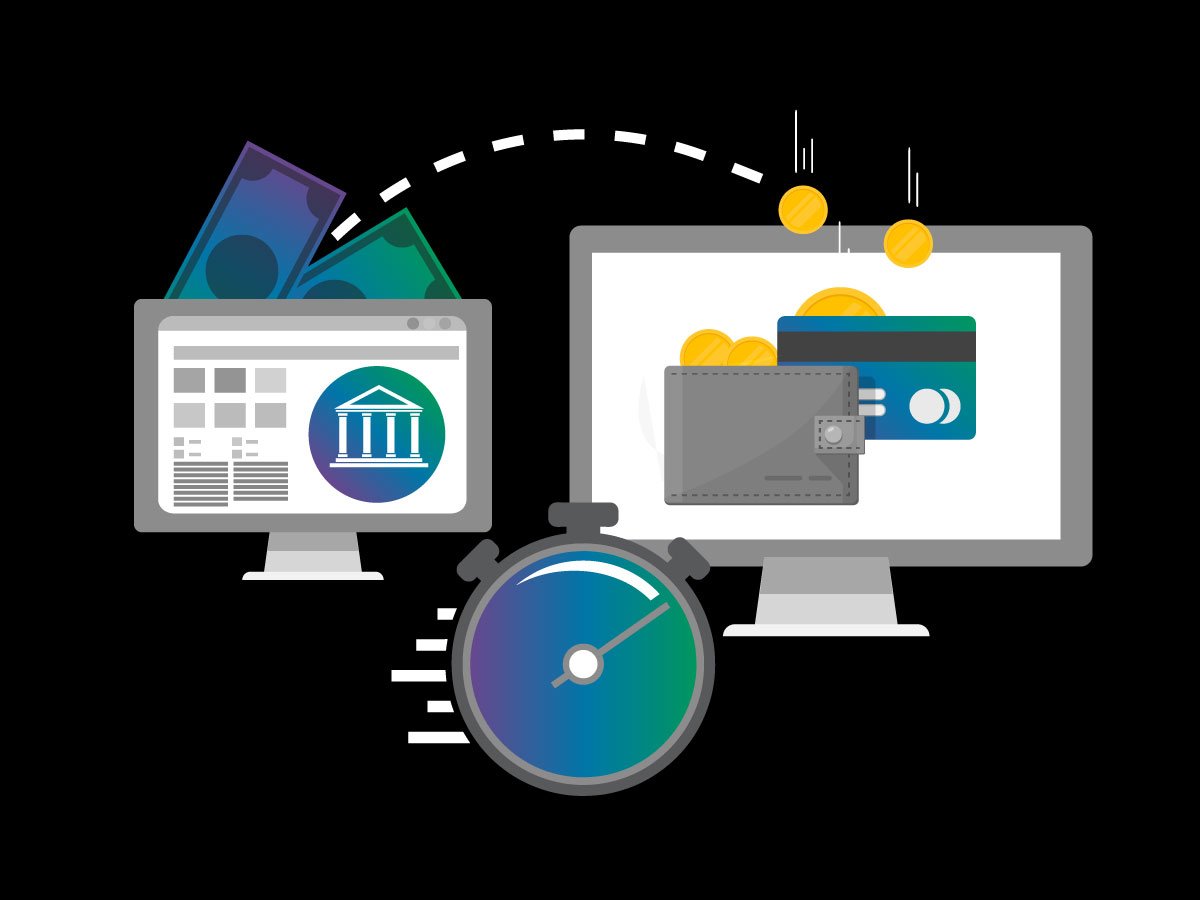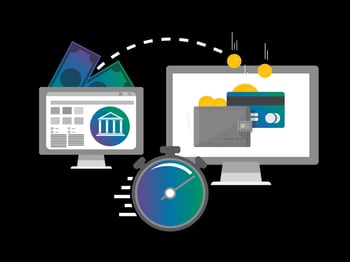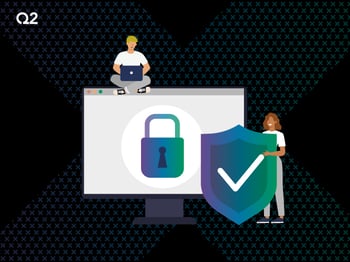While faster and guaranteed payments through the new instant payments rail—RTP® and FedNowSM—will certainly address many consumer payment pain points, solving the challenges associated with business payments goes well beyond payment settlement in real time. Of the estimated $25 trillion in B2B payments in the U.S., 33% are still made via check. Given that the majority of B2B payments can be scheduled well in advance, why do businesses continue to use checks? In a word: data.
B2B Payment Challenges
To understand the challenges businesses face with processing incoming and outgoing payments, we need to look at the payment process from end to end. After a business has agreed to provide goods or services to another business, this triggers the start of the payment process between the two businesses. The end-to-end process includes the supplier accounts receivable (AR) processes and the payer accounts payable (AP) processes. Both the AR and AP processes require an exchange of data between the supplier and payer.
A high percentage of B2B invoices are partially paid by the payer for reasons such as partial delivery, disputes, and other considerations. As a result, the details about what is being paid for are critical to both the supplier and the payer, as the lack of these details can result in delays and misapplied payments, both of which have adverse impacts on the supplier and payer. Therefore, regardless of whether the payment is made this minute, later today, next week, or next month, the data associated with the payment is required by both the supplier and the payer.
Today’s B2B Payments
Many businesses use electronic payments offered by the financial services industry, such as ACH and wire. However, these businesses still use checks for a significant portion of their B2B payments, even though invoice data can be included with ACH and wire payments. Why? Because the payment process is initiated by the payer once the amount to be paid is determined, which requires the payer to either enter the invoice data manually or upload the data from their AP system. While payers may be willing to do this for some of their critical payments, doing this for all their B2B payments has a significant impact on their efficiency. So even though it is as much as 100 times cheaper to send money via an electronic payment option, they paperclip a check to the invoice and throw it in the mail.
This may sound completely irrational if you think about the payment execution in isolation. Why would any business be willing to pay up to 100 times more to send a check instead of using an electronic payment option? To answer that question, we need to look at what happens before and after the payment execution. Those before and after processes are significantly impacted when the invoice data does not travel with the payment.
Even with an electronic payment, 78% of the time the invoice data is sent via email or U.S. mail and will require manual processes to reconcile and post the payment. Each manual process impacts supplier days sales outstanding (DSO) and payer days payable outstanding (DPO) and creates operational inefficiencies for both. DSO and DPO impact and operational inefficiencies cost businesses far more than executing any type of payment, which is a primary reason businesses will continue to use checks until there is a solution that solves their operational pain points associated with processing incoming and outgoing payments.
Introducing Instant Payments
While “real-time” steals the headlines, the hidden value of instant payments lies within the ISO 20022 message structures offered by the new payment rail. These new message structures are designed to support the end-to-end payment flow that starts with request for payment and ends with confirmation of payment receipt. And all along the way, the data travels with the payment flow. It’s the data capability that really sets the new instant payment rail apart from today’s ACH and wire payment solutions.
If ACH (CTX, CCD+) and wire (extended remittance) transactions can also carry data, what makes instant payments different? A big difference is associated with where the payment process starts. For a B2B payment, the instant payment process can start with a Request for Payment (RFP) message from the supplier to the payer. This RFP message can include digitized invoice data or a link (URL) to an image of an invoice. So right from the start of the payment workflow, the supplier includes invoice details needed to process the payment, removing the burden on the payer to provide this information when they execute the payment, which is both inefficient and time-consuming for the payer.
Wait a minute, many B2B invoices are partially paid, so how does instant payments handle these situations? This is another big advantage of instant payments. Using the Request for Information (RFI) message, payers can ask suppliers for additional information about the invoice and reach an agreement with the supplier on what will be paid—well before the payment is scheduled and initiated. In today’s payment environment, communication between the supplier and payer on what will be paid typically happens after the payment is processed once the remittance information reaches the supplier.
Sounds great, but what if the payer does not want to make the payment immediately? While it is true that instant payments will settle in real time, this does not mean that instant payments cannot be scheduled for the future. Instant payments are executed by the payer initiating a Credit Transfer (CT) message. While the instant payments rail will process the payment in real time once initiated by the payer, digital payment systems can allow payers to future date that execution, just like payers can do with ACH and wire payments today. So even if the payer wants to execute the payment later in the day, later this week, two weeks from today, or two months from today, the instant payments rail can still be used to execute that payment.
This still sounds like instant payments is focused on payer pain points. How does it help suppliers? Cash is still king for most businesses. Delays associated with collecting for goods and services rendered can seriously impact the cash flow of a business. Today, businesses have limited visibility into where an expected incoming payment is in the process. To find out, businesses resort to collection phone calls and emails to their payers, which may strain the relationship with their business customers. The instant payments rail will facilitate an audit trail of the RFP and RFI messages exchanged with the payer. This increases the visibility of where each outstanding invoice is in the payment process, eliminating unnecessary follow-up that costs the supplier time and effort and could also upset their customers. Once the payment is received via an incoming CT message from the payer, the supplier will have the remittance data needed to efficiently post the payment to the accounting system and confirm the posting by sending a Receipt Confirmation message to the payer. While instant payments will certainly provide benefits to payers, the potential benefits to the supplier may actually be far greater.
Innovation Will Push Instant Payments Adoption
The data capabilities within the messaging structure of the new instant payments rail unlocks opportunities to improve B2B payment processing for both the payer and the supplier. Innovators that understand the pain points associated with B2B payments—and apply design thinking to create solutions for these pain points—will drive adoption of instant payments. Traditionally, the financial services industry has offered businesses payment utilities that were designed from the financial institution perspective and then trained businesses how to bank. Following this same paradigm and treating instant payments as just another payment option will not drive adoption.
After getting past “instant payments,” innovators will realize that the underlying data and messaging of instant payments will modernize both AR and AP processes for businesses. They will embed instant payments data and messaging into AR/AP processes that make sense to the business, such that the actual payment execution will be the least interesting part of the process. In essence, the actual payment will become invisible. These solutions will drive real value for the businesses by reducing DSO and DPO with significant improvement in efficiency.
What’s in It for Financial Institutions
With the global B2B payment volume expected to hit $200 trillion by 2028, B2B payments is a big industry and extremely important to financial institutions. However, if financial institutions do not embrace the opportunity instant payments creates to modernize B2B payment flows, they will be relegated to transaction processors, drastically reducing their share of the new value created. Businesses of all sizes are very willing to pay for value, and solutions that improve DSO, DPO, and efficiency will certainly create value. So it’s a question of how much value the financial institutions can provide.
Traditionally, financial institutions have been paid for value through transaction fees. Typically, businesses pay a nominal fee per ACH, wire, and check payment initiated, and pay no transaction fee for incoming payments. Not surprisingly, many cash management product managers expect instant payments to be priced somewhere between the ACH and wire transaction fees—between 3 cents and $30 per transaction initiated. But what about the RFP and RFI messages and the new value that can be created on the AR side of the ledger?
The opportunity for instant payments to create new value for both payers and suppliers may challenge the payer-based transactional pricing models. Split or even supplier-based pricing models may make more sense for solutions built around the instant payments rail. Regardless of the pricing model chosen, financial institutions that can align fees directly with the value generated will have the most success. Providing high-value solutions that solve the pain points associated with B2B payments will enable financial institutions to deepen relationships and drive new non-interest revenue streams.
Will Instant Payments Increase Fraud?
Because instant payments are “certain and final” and can’t be canceled or automatically recalled, many financial institutions are worried that fraudsters will become active on the networks, moving money “right out the door.” While this concern is completely rational, the ability for instant payments to support the end-to-end payment flow, along with leveraging fraud and risk tools already in place for other payment types, may make instant payments less susceptible to fraud.
In today’s environment, what happens before and after the payment is completely outside of the banking systems, which creates opportunities for social engineering attacks, such as fraudsters convincing AP clerks to initiate fraudulent payments on behalf of a company executive. The end-to-end flow enabled by instant payments creates a private conversation between the supplier and the payer throughout the payment process, making it much more difficult for fraudsters to trick both the supplier and payer to route payments to a different account. Dual approval, multifactor authentication, and behavioral analytics that are all leveraged for ACH and wire payments will also apply to instant payments. In the end, instant payments may very well become the most secure payment rail available, despite the “certain and final” nature of the settlement.
Where Does It Go From Here?
While financial institutions work to connect to the instant payments networks and adjust their operational processes to deal with the 24X7 payment environment, innovators will continue to explore opportunities to modernize B2B payment processes for businesses. There are still some open questions about directories, tokenization, and image repositories that need to be addressed to support the end-to-end B2B payment flow. These should be worked out in the upcoming months as new solutions are developed around the instant payments rail.
Within the next several months, new B2B payment solutions that leverage instant payments will begin to show up in the market. Financial institutions that have prepared for instant payments on their own or through partnerships will be in the best position to take advantage of these new solutions to win and expand business relationships. Those that wait and see may be surprised that instant payments is more than just another payments rail.
We'll take a deep dive into the topic in our upcoming webinar, "Planning for RTP and FedNow Services." Register to attend today.





